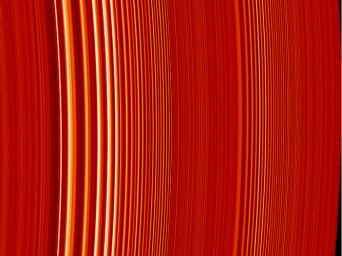
|
Catching Saturn’s Ring Waves
- Click the image above for a larger view
- Full-Res JPEG (802 x 601) (90.5 kB)
- Full-Res TIFF (802 x 601) (484.3 kB)
Caption:
This false color image of two density waves in Saturn's A ring was made from the stellar occultation observed by Cassini's ultraviolet imaging spectrograph when the spacecraft was 6.3 million kilometers (4 million miles) from Saturn.
Bright areas indicate the denser regions of the rings. The bright bands in the left part of the image are the "peaks" of a density wave caused by gravitational stirring of the rings by Saturn's moon, Janus. A smaller density wave in the right half of the image is produced by the moon Pandora. The ultraviolet imaging spectrograph observed the brightness of the star Xi Ceti as the rings passed in front of it, and the flickering of the starlight was converted into the ring density depicted by the image. The image represents a distance of about 724 kilometers (450 miles), and the smallest features are about one-half mile across.
Background Info:
The Cassini-Huygens mission is a cooperative project of NASA, the European Space Agency and the Italian Space Agency. The Jet Propulsion Laboratory, a division of the California Institute of Technology in Pasadena, manages the Cassini-Huygens mission for NASA's Science Mission Directorate, Washington, D.C. The Cassini orbiter was designed, developed and assembled at JPL. The ultraviolet imaging spectrograph was built at, and the team is based at the University of Colorado, Boulder.
For more information about the Cassini-Huygens mission, visit http://saturn.jpl.nasa.gov and the ultraviolet imaging spectrograph team home page, http://lasp.colorado.edu/cassini .
Cataloging Keywords:
| Name | Value | Additional Values |
|---|---|---|
| Target | Saturn Rings | A Ring, Janus, Pandora, Saturn |
| System | Saturn | |
| Target Type | Ring | Planet, Satellite |
| Mission | Cassini-Huygens | |
| Instrument Host | Cassini Orbiter | |
| Host Type | Orbiter | |
| Instrument | Ultraviolet Imaging Spectrometer (UVIS) | |
| Detector | ||
| Extra Keywords | Color, Disk, Occultation, Ultraviolet, Wave | |
| Acquisition Date | ||
| Release Date | 2004-11-09 | |
| Date in Caption | ||
| Image Credit | NASA/JPL/University of Colorado at Boulder | |
| Source | photojournal.jpl.nasa.gov/catalog/PIA06994 | |
| Identifier | PIA06994 | |
